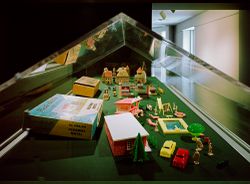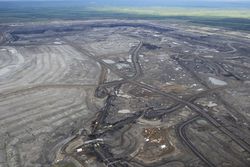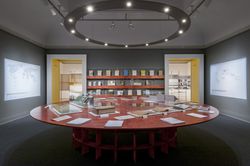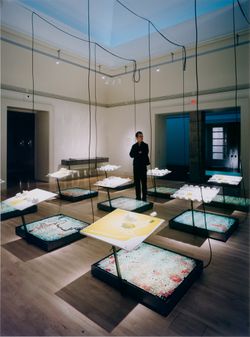Not only do toys provide evidence of the social and economic life of their period, but architectural toys ranging from wooden building blocks to iron and steel construction sets reflect distinct stylistic predilections and technological advances. New industrial and building techniques were used not only to create the new building types transforming our cities, but were(...)
Octagonal gallery
28 November 1990 to 31 March 1991
Buildings in Boxes: Architectural Toys from the CCA
Actions:
Description:
Not only do toys provide evidence of the social and economic life of their period, but architectural toys ranging from wooden building blocks to iron and steel construction sets reflect distinct stylistic predilections and technological advances. New industrial and building techniques were used not only to create the new building types transforming our cities, but were(...)
Octagonal gallery
textual records
Nuns' Island
ARCH267303
Description:
This group consists of plans (sections, site plans and details), a report on the socio-economique considerations of the development of Île St-Paul (present-day Île-des-Sœurs) in Verdun, Québec, and a preliminary cost analysis of the differents schemes of the project. There is also correspondence and a reference brochure for a similar project in Ottawa.
1964
Nuns' Island
Actions:
ARCH267303
Description:
This group consists of plans (sections, site plans and details), a report on the socio-economique considerations of the development of Île St-Paul (present-day Île-des-Sœurs) in Verdun, Québec, and a preliminary cost analysis of the differents schemes of the project. There is also correspondence and a reference brochure for a similar project in Ottawa.
textual records
1964
events
Learning from... Astana
Jeffrey Inaba, principal of the Los Angeles-based firm INABA, examines the urban centre and capital city of Kazakhstan, the ninth largest country in the world with a proportionally small population of 16 million people. With its rich oil and natural gas reserves and strategic geographical location, Kazakhstan is poised to experience an economic boom and has already(...)
Paul Desmarais Theatre
19 April 2007 , 7pm
Learning from... Astana
Actions:
Description:
Jeffrey Inaba, principal of the Los Angeles-based firm INABA, examines the urban centre and capital city of Kazakhstan, the ninth largest country in the world with a proportionally small population of 16 million people. With its rich oil and natural gas reserves and strategic geographical location, Kazakhstan is poised to experience an economic boom and has already(...)
events
19 April 2007
7pm
Paul Desmarais Theatre
Learning from... Calgary
Andrew Nikiforuk presents a talk entitled The political architecture of extreme oil, on the rapid development of bitumen in northern Alberta and its effects on the character of the region, and the country. Although the problems of oil exporting countries are well studied, Canada has yet to consider them or prepare for future oil price shocks. A journalist, Andrew(...)
Théâtre Paul-Desmarais
17 March 2011 , 7pm
Learning from... Calgary
Actions:
Description:
Andrew Nikiforuk presents a talk entitled The political architecture of extreme oil, on the rapid development of bitumen in northern Alberta and its effects on the character of the region, and the country. Although the problems of oil exporting countries are well studied, Canada has yet to consider them or prepare for future oil price shocks. A journalist, Andrew(...)
Théâtre Paul-Desmarais
The beginning of the 1950s was a moment of global upheaval. From India to Morocco, from Guatemala to Indochina, the process of decolonization gained momentum and the Cold War began. Architects working or acting as experts in the non-Western areas of the globe could no longer plan as if sites were terrains vague and people were mute subjects. The end of colonial(...)
Main galleries Keyword(s):
Casablanca, Chandigarh, Le Corbusier, Jeanneret, Morocco, Punjab, India, Morocco, modernism, Africa, Takashi Homma, Yto Barrada
26 November 2013 to 20 April 2014
How architects, experts, politicians, international agencies and citizens negotiate modern planning: Casablanca Chandigarh
Actions:
Description:
The beginning of the 1950s was a moment of global upheaval. From India to Morocco, from Guatemala to Indochina, the process of decolonization gained momentum and the Cold War began. Architects working or acting as experts in the non-Western areas of the globe could no longer plan as if sites were terrains vague and people were mute subjects. The end of colonial(...)
Main galleries Keyword(s):
Casablanca, Chandigarh, Le Corbusier, Jeanneret, Morocco, Punjab, India, Morocco, modernism, Africa, Takashi Homma, Yto Barrada
Launched in November 1998 by the International Foundation for the Canadian Centre for Architecture, The CCA Competition for the Design of Cities invited architects from around the world to submit solutions to a problem facing all major cities at the dawn of the twenty-first century: how to repair the scars left by transportation structures that are vestiges from a bygone(...)
Main galleries
15 November 2000 to 1 April 2001
New York: CCA Competition for the Design of Cities
Actions:
Description:
Launched in November 1998 by the International Foundation for the Canadian Centre for Architecture, The CCA Competition for the Design of Cities invited architects from around the world to submit solutions to a problem facing all major cities at the dawn of the twenty-first century: how to repair the scars left by transportation structures that are vestiges from a bygone(...)
Main galleries
Nuit Blanche 2025: 38%
It is time for a systemic change in the way we design and value the built environment. The way we build is not ecologically sustainable. The building industry is responsible for 38% of the worlds annual production of greenhouse gases. During the Nuit Blanche at the CCA, we invite you to come and discuss, reflect and be inspired by the actions of the German architecture(...)
Nuit Blanche 2025
1 March 2025 to 2 March 2025, 7pm to 1am
Nuit Blanche 2025: 38%
Actions:
Description:
It is time for a systemic change in the way we design and value the built environment. The way we build is not ecologically sustainable. The building industry is responsible for 38% of the worlds annual production of greenhouse gases. During the Nuit Blanche at the CCA, we invite you to come and discuss, reflect and be inspired by the actions of the German architecture(...)
Nuit Blanche 2025
events
Speed and its Limits
Speed and its Limits explores the pivotal role played by speed in modern life: from art to architecture and urbanism to graphics and design to economics to the material culture of the eras of industry and information. A colloquium organised by the CCA, in collaboration with the Wolfsonian-Florida International University and Stanford Humanities Lab, in preparation for the(...)
Paul Desmarais Theatre
21 June 2008, 9am - 5pm
Speed and its Limits
Actions:
Description:
Speed and its Limits explores the pivotal role played by speed in modern life: from art to architecture and urbanism to graphics and design to economics to the material culture of the eras of industry and information. A colloquium organised by the CCA, in collaboration with the Wolfsonian-Florida International University and Stanford Humanities Lab, in preparation for the(...)
events
21 June 2008
9am - 5pm
Paul Desmarais Theatre
Project
AP001.S6.1924.PR04
Description:
La construction de l’Université de Montréal s’est effectuée sur plusieurs années. Cormier est architecte en chef entre 1924 et 1947 et agit à titre d’architecte-conseil et d’ingénieur-conseil entre 1950 et 1961. Il semblait inévitable de diviser le cadre de classement en deux phases pour bien distinguer le rôle et l’implication de Cormier qui diffère durant ces deux périodes. La présence de deux plans d’ensembles très différents proposés en 1931 et 1961 appuie cette décision. Cette première phase s’étend sur une aussi longue période puisque le processus de construction a été parsemé de problèmes logistiques et financiers. Dès le début des travaux, le sol cause des problèmes lors de l’excavation et engendre des coûts supplémentaires en plus de retarder le processus. Avec la crise financière qui frappe en 1929, les travaux sont progressivement stoppés. De plus, les conditions météorologiques vont endommager une partie de la toiture et de la maçonnerie qui avait déjà été entamée, ce qui vient encore une fois engendrer des coûts additionnels. Suite au contexte économique particulier, l’administration de l’UdeM demande l’aide financière du gouvernement provincial pour protéger ce qui avait déjà été construit du pavillon principal. Le bâtiment sera finalement repris en 1943 et inauguré en 1947. Suite aux nombreux problèmes qui parsèmeront la première phase, le plan initial proposé par Cormier qui comprenait un stade, un aréna et la maison des animaux, sera abandonné au détriment du pavillon principal. Les projets non-réalisés sont tout de même documenté dans leurs sous-séries respectives. Il est important de prendre note que les plans produits par Cormier concernant les ailes du pavillon principal qui allaient servir de Centre Hospitalier ne seront jamais réalisés. Différents départements vont plutôt occuper l’espace.
1924-1947
Université de Montréal - Phase 1
Actions:
AP001.S6.1924.PR04
Description:
La construction de l’Université de Montréal s’est effectuée sur plusieurs années. Cormier est architecte en chef entre 1924 et 1947 et agit à titre d’architecte-conseil et d’ingénieur-conseil entre 1950 et 1961. Il semblait inévitable de diviser le cadre de classement en deux phases pour bien distinguer le rôle et l’implication de Cormier qui diffère durant ces deux périodes. La présence de deux plans d’ensembles très différents proposés en 1931 et 1961 appuie cette décision. Cette première phase s’étend sur une aussi longue période puisque le processus de construction a été parsemé de problèmes logistiques et financiers. Dès le début des travaux, le sol cause des problèmes lors de l’excavation et engendre des coûts supplémentaires en plus de retarder le processus. Avec la crise financière qui frappe en 1929, les travaux sont progressivement stoppés. De plus, les conditions météorologiques vont endommager une partie de la toiture et de la maçonnerie qui avait déjà été entamée, ce qui vient encore une fois engendrer des coûts additionnels. Suite au contexte économique particulier, l’administration de l’UdeM demande l’aide financière du gouvernement provincial pour protéger ce qui avait déjà été construit du pavillon principal. Le bâtiment sera finalement repris en 1943 et inauguré en 1947. Suite aux nombreux problèmes qui parsèmeront la première phase, le plan initial proposé par Cormier qui comprenait un stade, un aréna et la maison des animaux, sera abandonné au détriment du pavillon principal. Les projets non-réalisés sont tout de même documenté dans leurs sous-séries respectives. Il est important de prendre note que les plans produits par Cormier concernant les ailes du pavillon principal qui allaient servir de Centre Hospitalier ne seront jamais réalisés. Différents départements vont plutôt occuper l’espace.
Project
1924-1947
The American Lawn: Surface of Everyday Life reveals the lawn as a domestic symbol, civic showplace, economic force, and national icon. Bungalows in tract developments, suburban corporate headquarters, and the White House are all alike in that they sit behind a lawn: a carefully contrived patch of “nature” that lies open to the sky and to a multitude of uses and(...)
Main galleries, octagonal gallery, and hall cases
16 June 1998 to 8 November 1998
The American Lawn: Surface of Everyday Life
Actions:
Description:
The American Lawn: Surface of Everyday Life reveals the lawn as a domestic symbol, civic showplace, economic force, and national icon. Bungalows in tract developments, suburban corporate headquarters, and the White House are all alike in that they sit behind a lawn: a carefully contrived patch of “nature” that lies open to the sky and to a multitude of uses and(...)
Main galleries, octagonal gallery, and hall cases





